Farmers’ Distress Index: An Approach for an Action Plan to Reduce Vulnerability in the Drylands of India
Abstract
:1. Introduction
1.1. Objectives of the Study
1.2. Research Questions
2. Materials and Methods
2.1. Study Area
2.2. Sampling Framework
2.3. Identification of Indicators
2.4. Screening of Variables for Final FDI
2.5. Collection of Primary Data
2.6. Tools and Techniques
2.7. Robustness Check (Out-of-Sample Validation)
3. Results and Discussions
3.1. General Profile of the Households
3.2. Measuring Multiple Dimensions of Distress
- Exposure (natural disaster), which is the magnitude and duration of the population’s exposure to distress.
- Adaptive capacity (socio-demographic profile, livelihood strategies, social networks), which denotes the household’s or farmer’s ability to resist and adapt to distress.
- Sensitivity (health, food, water), which is the degree to which a household is affected by distress.
- Mitigation and adaptation strategies, which are aimed at tackling the causes and minimizing the possible negative impacts of exposure to risk.
- Triggers, which are events or situations that provoke farmers to take extreme steps, such as suicide [61].
- Psychological factors, which are essential drivers of severe depression, isolation from society, etc.
- Impacts, which are the results of agrarian distress.
3.2.1. Exposure to Risk
3.2.2. Adaptive Capacity
3.2.3. Sensitivity
3.2.4. Mitigation and Adaptation Strategies
3.2.5. Triggers
3.2.6. Change in Social–Psychological Aspects
3.2.7. Impact
3.3. Dimension of Farmers’ Distress and the FDI
3.4. Utility of FDI
3.5. Scaling up to the Sub-District Level and Mapping of Vulnerability
- Category A mandals/blocks (demarcated as
): Severe mandal/block distress (top 30% of the mandals).
- Category B mandals/blocks (demarcated as
for moderate–high and
for moderate–low): Moderate mandal distress (30 to 60% of the mandals).
- Category C mandals (demarcated as
): Low mandal distress (bottom 40% of mandals).
4. Conclusions and Future Work
4.1. Main Research Findings
4.2. Policy Implications
4.3. Research Challenges and Future Work
Supplementary Materials
Author Contributions
Funding
Data Availability Statement
Acknowledgments
Conflicts of Interest
References
- Planning Commission. Final Report of Minor Irrigation and Watershed Management for the Twelfth Five Year Plan (2012–2017); Government of India: New Delhi, India, 2012; pp. 3–4. [Google Scholar]
- Food and Agricultural Organization. FAO India at a Glance, FAO in India. 2021. Available online: http://www.fao.org/india/fao-in-india/india-at-a-glance/en/ (accessed on 6 July 2021).
- Sindhuja, P.; Asokhan, M. Training Needs—An Analysis in Dryland Farming System with Gender Perspectives. Curr. Agric. Res. J. 2018, 6, 119–122. [Google Scholar] [CrossRef]
- Vijayan, R. Dryland agriculture in India—Problems and solutions. Asian J. Environ. Sci. 2016, 11, 171–177. [Google Scholar] [CrossRef]
- Krishi Jagran. Know about Dryland Agriculture and Farming Technology. 2017. Available online: https://krishijagran.com/news/know-about-dryland-agriculture-and-farming-technology/ (accessed on 23 October 2021).
- Delgado, J.A.; Groffman, P.M.; Nearing, M.A.; Goddard, T.; Reicosky, D.; Lal, R.; Kitchen, N.R.; Rice, C.W.; Towery, D.; Salon, P. Conservation practices to mitigate and adapt to the effects of climate change. J. Soil Water Conserv. Soc. 2011, 66, 118A–129A. [Google Scholar] [CrossRef] [Green Version]
- Gordon, L.J.; Finlayson, C.M.; Falkenmark, M. Managing water in agriculture for food production and other ecosystem services. Agric. Water Manag. 2010, 97, 512–519. [Google Scholar] [CrossRef]
- Whitlock, C.; Cross, W.; Maxwell, B.; Silverman, N.; Wade, A.A. Montana Climate Assessment; Montana Institute on Ecosystems, Montana State University, and University of Montana: Missoula, MT, USA, 2017. [Google Scholar]
- Lawrence, P.G.; Maxwell, B.D.; Rew, L.J.; Ellis, C.; Bekkerman, A. Vulnerability of dryland agricultural regimes to economic and climatic change. Ecol. Soc. 2018, 23, 34. [Google Scholar] [CrossRef] [Green Version]
- Venkateswarlu, B.; Shaker, A.K. Dryland Agriculture: Bringing Resilience to Crop Production Under Changing Climate. In Crop Stress and Its Management: Perspectives and Strategies; Springer: Dordrecht, The Netherlands, 2012. [Google Scholar]
- Raghavan, S.A.; Funk, C.; Aenis, T.; Winker, P.; Breuer, L. Sensitivity analysis of a climate vulnerability index—A case study from Indian watershed development programmes. Clim. Chang. Responses 2018, 5, 1. [Google Scholar] [CrossRef]
- Kumar, S. Agrarian Crisis and Framers Issues in India. From Indebtedness to Suicide. In Agrarian Crisis and Farmers Suicide in India. The Voice Unheard; Best Publishing House: New Delhi, India, 2020; pp. 125–154. [Google Scholar]
- Krishnamurthy, P.K.; Lewis, K.; Choularton, R.J. Climate Impacts on Food Security and Nutrition—A Review of Existing Knowledge; Met Office and WFP’s Office for Climate Change, Environment and Disaster Risk Reduction: Exeter, UK, 2012. [Google Scholar]
- European Cooperation in Science and Technology. Food Security in Drylands under a Changing Climate; Policy Brief; European Cooperation in Science and Technology: Brussels, Belgium, 2019. [Google Scholar]
- Montana, E.; Diaz, H.P.; Hurlbert, M. Development, local livelihoods, and vulnerabilities to global environmental change in the South American Dry Andes. Reg. Environ. Chang. 2016, 16, 2215–2228. [Google Scholar] [CrossRef]
- Sathyan, A.R.; Funk, C.; Aenis, T.; Breuer, L. Climate Vulnerability in Rainfed Farming: Analysis from Indian Watersheds. Sustainability 2018, 10, 3357. [Google Scholar] [CrossRef] [Green Version]
- Rao, C.S.; Kareemulla, K.; Krishnan, P.; Murthy, G.R.K.; Ramesh, P.; Ananthan, P.S.; Joshi, P.K. Agro-ecosystem based sustainability indicators for climate resilient agriculture in India: A conceptual framework. Ecol. Indic. 2019, 105, 621–633. [Google Scholar] [CrossRef]
- Burnham, M.; Ma, Z. Climate change adaptation: Factors influencing Chinese smallholder farmers perceived self-efficacy and adaptation intent. Reg. Environ. Chang. 2017, 17, 171–186. [Google Scholar] [CrossRef]
- National Intelligence Council. Impact of Climate Change to 2030—A Commissioned Research Report. Office of the Director of National Intelligence: New Delhi, India, 2009. [Google Scholar]
- Suryanto, S.; Rahman, A. Application of livelihood vulnerability index to assess risks for farmers in the Sukoharjo Regency and Klaten Regency, Indonesia. Jàmbá J. Disaster Risk Stud. 2019, 11, a739. [Google Scholar] [CrossRef] [Green Version]
- Guerrero Lara, L.; Pereira, L.M.; Ravera, F.; Jiménez-Aceituno, A. Flipping the Tortilla: Social-ecological innovations and traditional ecological knowledge for more sustainable agri-food systems in Spain. Sustainability 2019, 11, 1222. [Google Scholar] [CrossRef] [Green Version]
- McDowell, J.Z.; Hess, J.J. Accessing adaptation: Multiple stressors on livelihoods in the Bolivian highlands under a changing climate. Glob. Environ. Chang. 2012, 22, 342–352. [Google Scholar] [CrossRef]
- Yenneti, K.; Tripathi, S.; Wei, Y.D.; Chen, W.; Joshi, G. The truly disadvantaged? Assessing social vulnerability to climate change in urban India. Habitat Int. 2016, 56, 124–135. [Google Scholar] [CrossRef]
- Lavell, A. Unpacking Climate Change Adaptation and Disaster Risk Management: Searching for the Links and the Differences: A Conceptual and Epistemological Critique and Proposal; IUCN-Flacso Project on Climate Change Adaptation and Disaster Risk Reduction; International Union for Conservation of Nature: Gland, Switzerland, 2011. [Google Scholar]
- Dong, Z.; Pan, Z.; An, P.; Wang, L.; Zhang, J.; He, D.; Han, H.; Pan, X. A novel method for quantitatively evaluating agricultural vulnerability to climate change. Ecol. Indic. 2015, 48, 49–54. [Google Scholar] [CrossRef]
- Wisner, B.P. Who? What? Where? When? in an emergency: Notes on possible indicators of vulnerability and resilience: By phase of the disaster management cycle and social actor’. In Environment and Human Security, Contributions to a Workshop in Bonn; Plate, E., Ed.; Environment and Human Security: Bonn, Germany, 2002. [Google Scholar]
- Raju, K.V.; Deshpande, R.S.; Satyasiba, B. Socio-economic and Agricultural Vulnerability Across Districts of Karnataka. In Climate Change Challenge (3C) and Social-Economic-Ecological Interface-Building; Nautiyal, S., Schaldach, R., Raju, K.V., Kaechele, H., Pritchard, B., Rao, K.S., Eds.; Environmental Science and Engineering; Springer: Berlin/Heidelberg, Germany, 2016; pp. 161–190. [Google Scholar] [CrossRef]
- Madhuri; Tewari, H.R.; Bhowmick, P.K. Livelihood vulnerability index analysis: An approach to study vulnerability in the context of Bihar. Jamba J. Disaster Risk Stud. 2014, 6, a127. [Google Scholar] [CrossRef] [Green Version]
- Chambers, R. Editorial introduction: Vulnerability, coping and policy. IDS Bull. 1989, 2, 1–7. [Google Scholar] [CrossRef] [Green Version]
- Gatto, A. A pluralistic approach to economic and business sustainability: A critical meta-synthesis of foundations, metrics, and evidence of human and local development. Corp. Soc. Responsible Environ. Manag. 2020, 27, 1525–1539. [Google Scholar] [CrossRef]
- Taleb, N.N. Antifragile: Things That Gain from Disorder; Random House Incorporated: New York, NY, USA, 2012. [Google Scholar]
- Gatto, A. Historical roots of microcredit and usury: The role of Monti di Pietà in Italy and in the kingdom of Naples in XV–XX centuries. J. Int. Dev. 2018, 30, 911–914. [Google Scholar] [CrossRef]
- Gatto, A.; Drago, C. A taxonomy of energy resilience. Energy Policy 2020, 136, 111007. [Google Scholar] [CrossRef]
- Agovino, M.; Cerciello, M.; Gatto, A. Policy efficiency in the field of food sustainability. The adjusted food agriculture and nutrition index. J. Environ. Manag. 2018, 218, 220–233. [Google Scholar] [CrossRef]
- Saini, S.; Khatri, P. Indian Farmers Need a New Distress Index. Just Suicide Data Won’t Do. 2021. Available online: https://theprint.in/opinion/indian-farmers-need-a-new-distress-index-just-suicide-data-wont-do/677817/ (accessed on 12 July 2021).
- Harvey, C.A.; Rakotobe, Z.L.; Rao, N.S.; Dave, R.; Razafimahatratra, H.; Rabarijohn, R.H.; Rajaofara, H.; MacKinnon, J.L. Extreme vulnerability of smallholder farmers to agricultural risks and climate change in Madagascar. Philos. Trans. R. Soc. B Biol. Sci. 2014, 369, 20130089. [Google Scholar] [CrossRef] [Green Version]
- Frank, J.; Penrose-Buckley, C. Small-Scale Farmers and Climate Change: How Can Farmer Organisations and Fairtrade Build the Adaptive Capacity of Smallholders? International Institute for Environment and Development: London, UK, 2012. [Google Scholar]
- Acharya, R.; Porwal, A. A vulnerability index for the management of and response to the COVID-19 epidemic in India: An ecological study. Lancet Glob. Health 2020, 8, e1142–e1151. [Google Scholar] [CrossRef]
- Sarkar, A.; Chouhan, P. COVID-19: District level vulnerability assessment in India. Clin. Epidemiol. Glob. Health 2021, 9, 204–215. [Google Scholar] [CrossRef]
- Hahn, M.B.; Riederer, A.M.; Foster, S.O. The livelihood vulnerability index: A pragmatic approach to assessing risks from climate variability and change—A case study in Mozambique. Glob. Environ. Change 2009, 19, 74–88. [Google Scholar] [CrossRef]
- Ahsan, M.N.; Warner, J. The socioeconomic vulnerability index: A pragmatic approach for assessing climate change led risks–A case study in the south-western coastal Bangladesh. Int. J. Disaster Risk Reduct. 2014, 8, 32–49. [Google Scholar] [CrossRef]
- Shah, K.U.; Dulal, H.B.; Johnson, C.; Baptiste, A. Understanding livelihood vulnerability to climate change: Applying the livelihood vulnerability index in Trinidad and Tobago. Geoforum 2013, 47, 125–137. [Google Scholar] [CrossRef]
- Pandey, R.; Jha, S. Climate vulnerability index-measure of climate change vulnerability to communities: A case of rural Lower Himalaya, India. Mitig. Adapt. Strateg. Glob. Change 2012, 17, 487–506. [Google Scholar] [CrossRef]
- Debesai, M. Factors affecting vulnerability level of farming households to climate change in developing countries: Evidence from Eritrea. IOP Conf. Ser. Mater. Sci. Eng. 2020, 1001, 012093. [Google Scholar] [CrossRef]
- Reddy, A.A.; Rani, C.R.; Cadman, T.; Reddy, T.P.; Battarai, M.; Reddy, A.N. Rural Transformation of a Village in Telangana, A Study of Dokur since 1970s. Int. J. Rural. Manag. 2016, 12, 143–178. [Google Scholar] [CrossRef]
- JRC. The Challenge of Resilience in a Globalized World; Publications Office of the European Union: Luxembourg, 2015. [Google Scholar]
- Becker, S.P.; Burns, G.L.; Garner, A.A.; Jarrett, M.A.; Luebbe, A.M.; Epstein, J.N.; Willcutt, E.G. Sluggish cognitive tempo in adults: Psychometric validation of the Adult Concentration Inventory. Psychol. Assess. 2017, 30, 296–310. [Google Scholar] [CrossRef]
- Ray, S.S.; Sai, M.S.; Chattopadhyay, N. Agricultural drought assessment: Operational approaches in India with special emphasis on 2012. In High-Impact Weather Events Over the SAARC Region; Springer: Cham, Switzerland, 2015; pp. 349–364. [Google Scholar]
- National Crime Record Bureau. Available online: http://ncrb.gov.in (accessed on 12 July 2021).
- Chaudhary, A.; Verones, F.; De Baan, L.; Hellweg, S. Quantifying land use impacts on biodiversity: Combining species–area models and vulnerability indicators. Environ. Sci. Technol. 2015, 49, 9987–9995. [Google Scholar] [CrossRef]
- Gallai, N.; Salles, J.M.; Settele, J.; Vaissière, B.E. Economic valuation of the vulnerability of world agriculture confronted with pollinator decline. Ecol. Econ. 2009, 68, 810–821. [Google Scholar] [CrossRef]
- Karim, Z.; Hussain, S.G.; Ahmed, A.U. Climate change vulnerability of crop agriculture. In Vulnerability and Adaptation to Climate Change for Bangladesh; Springer: Dordrecht, The Netherlands, 1999; pp. 39–54. [Google Scholar]
- Vicuña, S.; McPhee, J.; Garreaud, R.D. Agriculture vulnerability to climate change in a snowmelt-driven basin in semiarid Chile. J. Water Resour. Plan. Manag. 2012, 138, 431–441. [Google Scholar] [CrossRef]
- Nelson, R.; Kokic, P.; Elliston, L.; King, J.A. Structural adjustment: A vulnerability index for Australian broadacre agriculture. Aust. Commod. Forecast Issues 2005, 12, 171–179. [Google Scholar]
- Etwire, P.M.; Al-Hassan, R.M.; Kuwornu, J.K.; Osei-Owusu, Y. Application of livelihood vulnerability index in assessing vulnerability to climate change and variability in Northern Ghana. J. Environ. Earth Sci. 2013, 3, 157–170. [Google Scholar]
- De Silva, R.P.; Dayawansa, N.D.K. Climate Change Vulnerability in Agriculture Sector: An Assessment and Mapping at Divisional Secretariat Level in Sri Lanka. Earth Syst. Environ. 2021, 5, 725–738. [Google Scholar] [CrossRef]
- Khan, N.A.; Gao, Q.; Abid, M.; Shah, A.A. Mapping farmers’ vulnerability to climate change and its induced hazards: Evidence from the rice-growing zones of Punjab, Pakistan. Environ. Sci. Pollut. Res. 2021, 28, 4229–4244. [Google Scholar] [CrossRef] [PubMed]
- Chauhan, N.; Shukla, R.; Joshi, P.K. Assessing impact of varied social and ecological conditions on inherent vulnerability of Himalayan agriculture communities. Hum. Ecol. Risk Assess. Int. J. 2020, 26, 2628–2645. [Google Scholar] [CrossRef]
- Klein, R.J.; Schipper, E.L.F.; Dessai, S. Integrating mitigation and adaptation into climate and development policy: Three research questions. Environ. Sci. Policy 2005, 8, 579–588. [Google Scholar] [CrossRef]
- Intergovernmental Panel on Climate Change (IPCC). Climate Change 2001: The Scientific Basis; Houghton, J.T., Ding, Y., Griggs, D.J., Noguer, M., van der Linden, P.J., Dai, X., Maskell, K., Johnson, C.A., Eds.; Contribution of Working Group I to the Third Assessment Report of the Intergovernmental Panel on Climate Change; Cambridge University Press: Cambridge, UK; New York, NY, USA, 2001. [Google Scholar]
- Ebi, K.; Kovats, R.S.; Menne, B. An approach for assessing human health vulnerability and public health interventions to adapt to climate change. Environ. Health Perspect. 2006, 114, 1930–1934. [Google Scholar] [CrossRef] [PubMed] [Green Version]
- Reddy, A.A. The Soil Health Card Scheme in India: Lessons Learned and Challenges for Replication in Other Developing Countries. J. Nat. Resour. Policy Res. 2019, 9, 124–156. [Google Scholar] [CrossRef]
- Ellis, F. The determinants of rural livelihood diversification in developing countries. J. Agric. Econ. 2000, 51, 289–302. [Google Scholar] [CrossRef]
- Castro, M.F. Defining and Using Performance Indicators and Targets in Government M and E Systems; PREM Notes and Special Series on the Nuts and Bolts of Government M&E Systems No. 12; World Bank: Washington, DC, USA, 2011. [Google Scholar]
- Debesai, M. Rural household income diversification in developing countries: A Case study of Eritrea. E3S Web Conf. 2020, 175, 13014. [Google Scholar] [CrossRef]
- Greco, S.; Ishizaka, A.; Tasiou, M.; Torrisi, G. On the methodological framework of composite indices: A review of the issues of weighting, aggregation, and robustness. Soc. Indic. Res. 2009, 141, 61–94. [Google Scholar] [CrossRef] [Green Version]
- OECD. Handbook on Constructing Composite Indicators: Methodology and User Guide; OECD Publishing: Paris, France, 2008. [Google Scholar]
- Dinesh, M.; Bassi, N.; Kishan, K.; Vedantam, N.; Sivamohan, M. The Factors Causing Agrarian Crisis in India: A Study from Four Agro-Ecological Regions in India; Final Report by IRAP Hyderabad; IRAP: Hyderabad, India, 2015; pp. vii–viii. [Google Scholar]
- United Nations of Development Program Home Page. Available online: https://www.undp.org/sustainable-development-goals (accessed on 2 November 2021).
- Food and Agricultural Organization (FAO). The State of the World’s Land and Water Resources for Food and Agriculture (SOLAW)—Managing Systems at Risk; Food and Agriculture Organization of the United Nations: Rome, Italy; Earthscan: London, UK, 2011. [Google Scholar]
- DFID. DFID Sustainable Livelihoods Guidance Sheets; ENN: Dongguan, China, 1999. [Google Scholar]
- Ghosh, N.; Yadav, S.S. Problems and Prospects of Crop Insurance: Reviewing Agricultural Risk and NAIS in India; Institute of Economic Growth, University of Delhi Enclave: Delhi, India, 2008. [Google Scholar]
- Vasavi, A.R. Agrarian distress in Bidar: Market, state and suicides. Econ. Political Wkly. 1999, 34, 2263–2268. [Google Scholar]
- Deshpande, R.S. Suicide by farmers in Karnataka: Agrarian distress and possible alleviatory steps. Econ. Political Wkly. 2002, 37, 2601–2610. [Google Scholar]
- Uutela, A. Economic crisis and mental health. Curr. Opin. Psychiatry 2010, 23, 127–130. [Google Scholar] [CrossRef]
- Merriott, D. Factors associated with the farmer suicide crisis in India. J. Epidemiol. Glob. Health 2016, 6, 217–227. [Google Scholar] [CrossRef] [Green Version]
- Dandekar, A.; Bhattacharya, S. Lives in debt: Narratives of Agrarian distress and farmer suicides. Econ. Political Wkly. 2017, 52, 77–84. [Google Scholar]
- Rao, P.N.; Suri, K.C. Dimensions of agrarian distress in Andhra Pradesh. Econ. Political Wkly. 2006, 41, 1546–1552. [Google Scholar]
- Reddy, A.A.; Raju, S.S.; Bose, A. Farmers’ Income, Indebtedness and Agrarian Distress in India. Microfinance Rev. 2019, 12, 19–38. [Google Scholar]
- Ramprasad, V. Debt and vulnerability: Indebtedness, institutions and smallholder agriculture in South India. J. Peasant Stud. 2019, 46, 1286–1307. [Google Scholar] [CrossRef]
- Green, W.N.; Bylander, M. The Exclusionary Power of Microfinance: Over-indebtedness and Land Dispossession in Cambodia. Sociol. Dev. 2021, 7, 202–229. [Google Scholar] [CrossRef]
- Misra, M. Commercial Micro-Credit, Neo-Liberal Agriculture and Smallholder Indebtedness: Three Bangladesh Villages. J. Contemp. Asia 2021, 51, 330–350. [Google Scholar] [CrossRef]
- Hofman, I. Soft budgets and elastic debt: Farm liabilities in the agrarian political economy of post-Soviet Tajikistan. J. Peasant Stud. 2018, 45, 1360–1381. [Google Scholar] [CrossRef]
- The World Bank. Overcoming Drought: Adaptation Strategies for Andhra Pradesh, India. Available online: https://openknowledge.worldbank.org/bitstream/handle/10986/7085/372600IN0Overc101OFFICIAL0USE0ONLY1.pdf?sequence=1&isAllowed=y (accessed on 17 July 2021).
- Tate, E. Uncertainty analysis for a social vulnerability index. Ann. Assoc. Am. Geogr. 2013, 103, 526–543. [Google Scholar] [CrossRef]
- Salazar-Briones, C.; Ruiz-Gibert, J.M.; Lomeli-Banda, M.A.; Mungaray-Moctezuma, A. An integrated urban flood vulnerability index for sustainable planning in arid zones of developing countries. Water 2020, 12, 608. [Google Scholar] [CrossRef] [Green Version]
- Khan, F.A.; Salman, A. A simple human vulnerability index to climate change hazards for Pakistan. Int. J. Disaster Risk Sci. 2012, 3, 163–176. [Google Scholar] [CrossRef] [Green Version]
- Said, F.; Musaddiq, T.; Mahmud, M.M. Level Determinants of Poverty: Investigation through Poverty Mapping of Districts of Pakistan. In Proceedings of the 27th Annual Meeting and Conference of Pakistan Society of Development Economists, Islamabad, Pakistan, 13–15 December 2011; pp. 13–15. [Google Scholar]
- Murthy, C.S.; Laxman, B.; Sai, M.S.; Diwakar, P.G. Analysing agricultural drought vulnerability at sub-district level through exposure, sensitivity and adaptive capacity based composite index. Int. Arch. Photogramm. Remote. Sens. Spat. Inf. Sci. 2014, 40, 65. [Google Scholar] [CrossRef] [Green Version]
- Patnaik, U.; Das, P.K.; Bahinipati, C.S. Analyzing vulnerability to climatic variability and extremes in the coastal districts of Odisha, India. Rev. Dev. Chang. 2013, 18, 173–189. [Google Scholar] [CrossRef]
- Kaul, V.; Thornton, T.F. Resilience and adaptation to extremes in a changing Himalayan environment. Reg. Environ. Chang. 2014, 14, 683–698. [Google Scholar] [CrossRef]
- Kantamaneni, K.; Rice, L.; Yenneti, K.; Campos, L.C. Assessing the vulnerability of agriculture systems to climate change in coastal areas: A novel index. Sustainability 2020, 12, 4771. [Google Scholar] [CrossRef]
- Ghosh, R.K. Performance Evaluation of Pradhan Mantri Fasal Bima Yojana (PMFBY): Part 1. Governance Analysis. Final Report; Indian Institute of Management Ahmedabad: Ahmedabad, India, 2018; pp. 85–86. [Google Scholar]
- Gulati, A.; Terway, P.; Hussain, S. Crop Insurance in India: Key Issues and Way Forward; Working Paper No. 352; Indian Council for Research on International Economic Relations: New Delhi, India, 2018; pp. v–vii. [Google Scholar]
- Simane, B. Building resilience to climate change and green economy in mountain ecosystems of Ethiopia: Integrating research, capacity building and sustainable development activities. In Proceedings of the Stakeholder’s Workshop, Debre Markos, Ethiopia, 10–13 June 2011. [Google Scholar]
- Timilsina, B.; Adhikari, N.; Kafle, S.; Paudel, S.; Gautam, D. Addressing impact of COVID-19 post pandemic on farming and agricultural deeds. Asian J. Adv. Res. Rep. 2020, 11, 28–35. [Google Scholar] [CrossRef]
- Cariappa, A.G.A.; Acharya, K.K.; Adhav, C.A.; Sendhil, R.; Ramasundarma, P. Impact of COVID-19 on the Indian agricultural system: A 10-point strategy for post-pandemic recovery. Outlook Agric. 2021, 50, 26–33. [Google Scholar] [CrossRef]
- Cattivelli, V.; Rusciano, V. Social innovation and food provisioning during COVID-19: The case of urban–rural initiatives in the province of Naples. Sustainability 2020, 12, 4444. [Google Scholar] [CrossRef]
- Rusciano, V.; Civero, G.; Scarpato, D. Social and Ecological High Influential Factors in Community Gardens Innovation: An Empirical Survey in Italy. Sustainability 2020, 12, 4651. [Google Scholar] [CrossRef]
- Rusciano, V.; Civero, G.; Scarpato, D. Urban gardens and environmental sustainability: An empirical research of Campania region. Calitatea 2017, 18, 376–381. [Google Scholar]
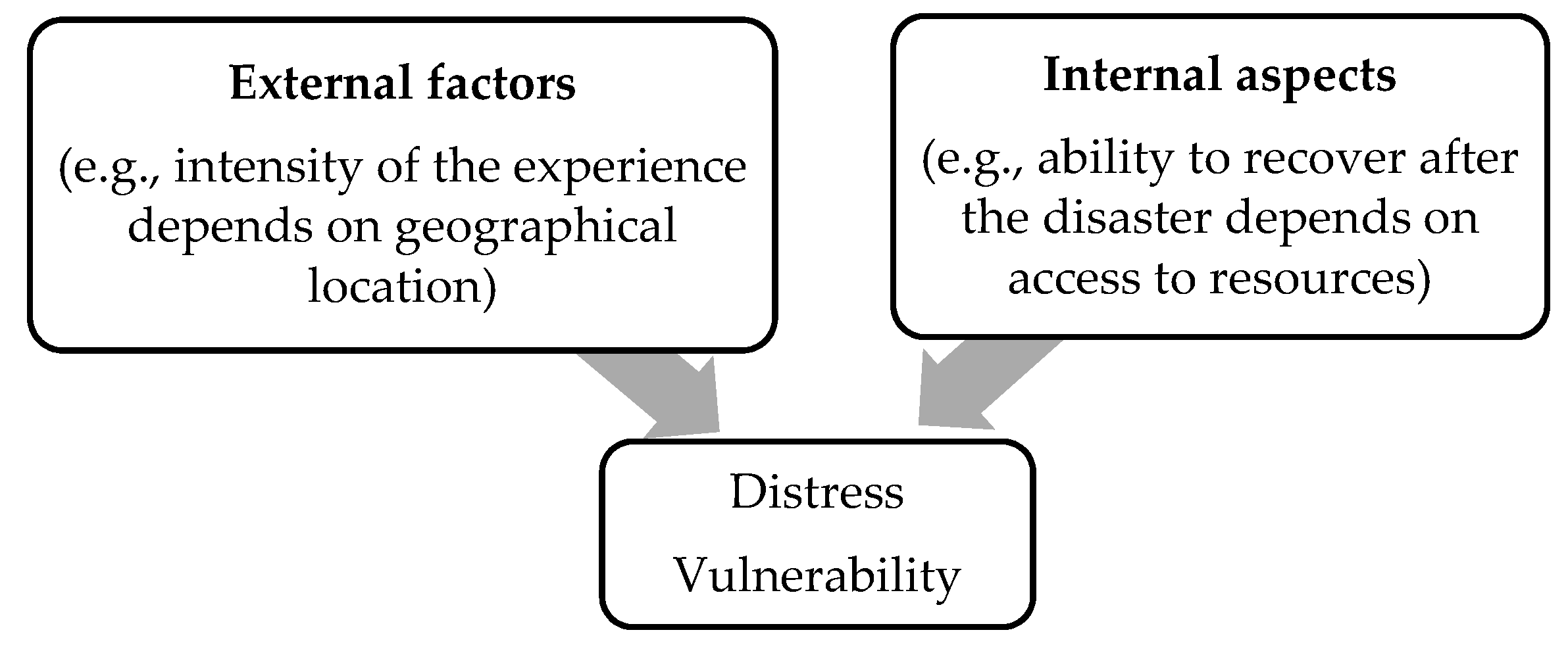
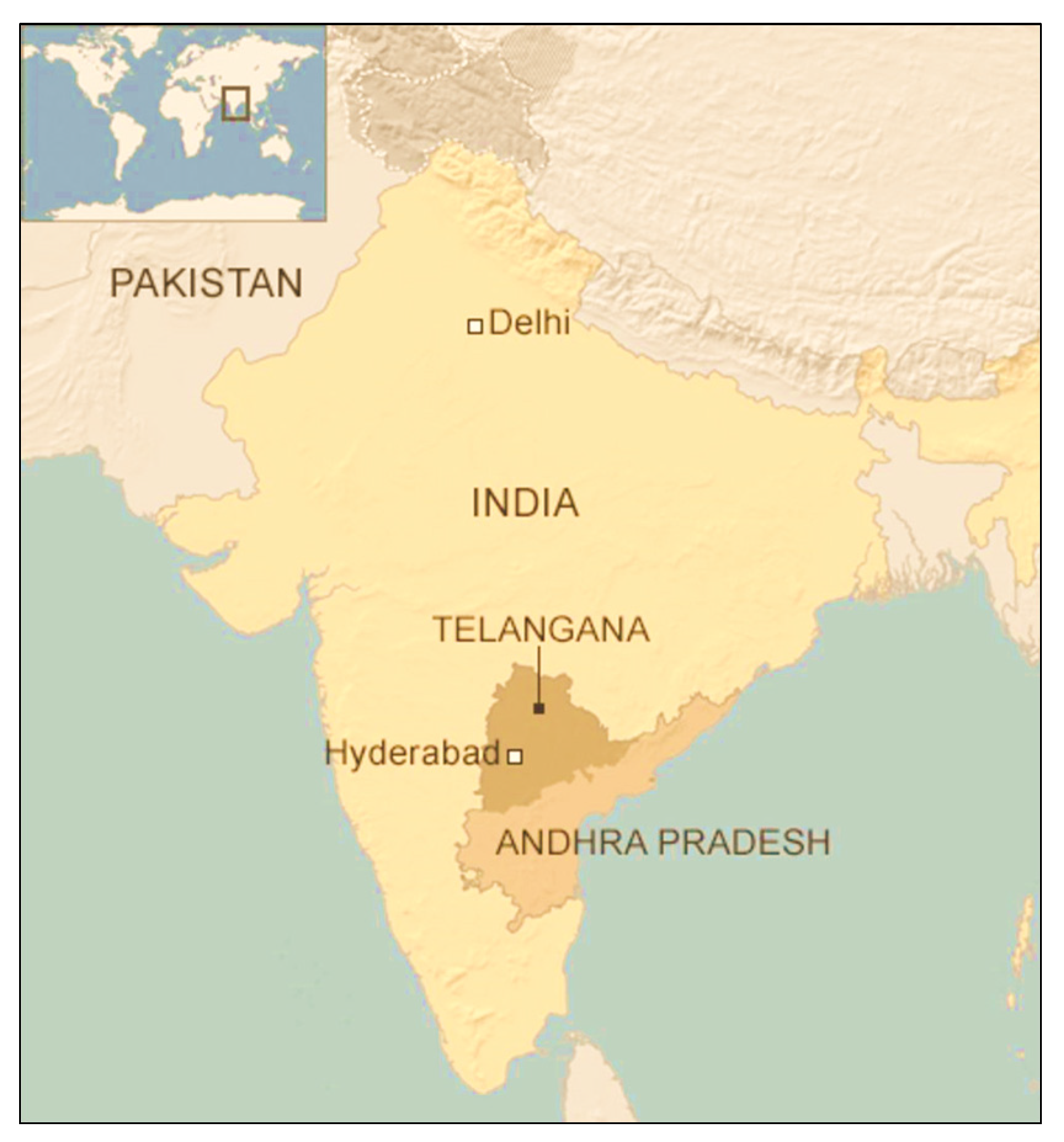

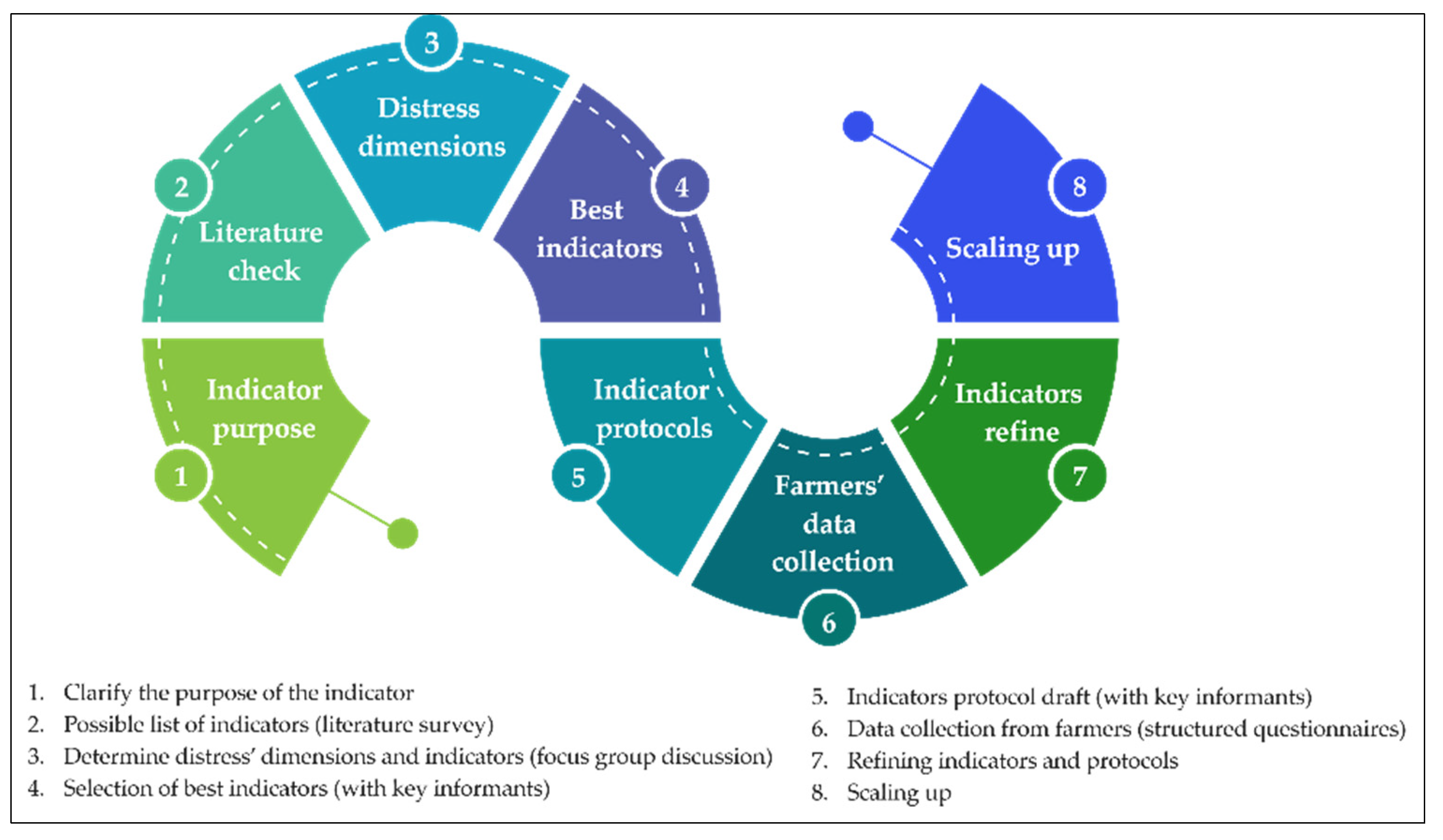
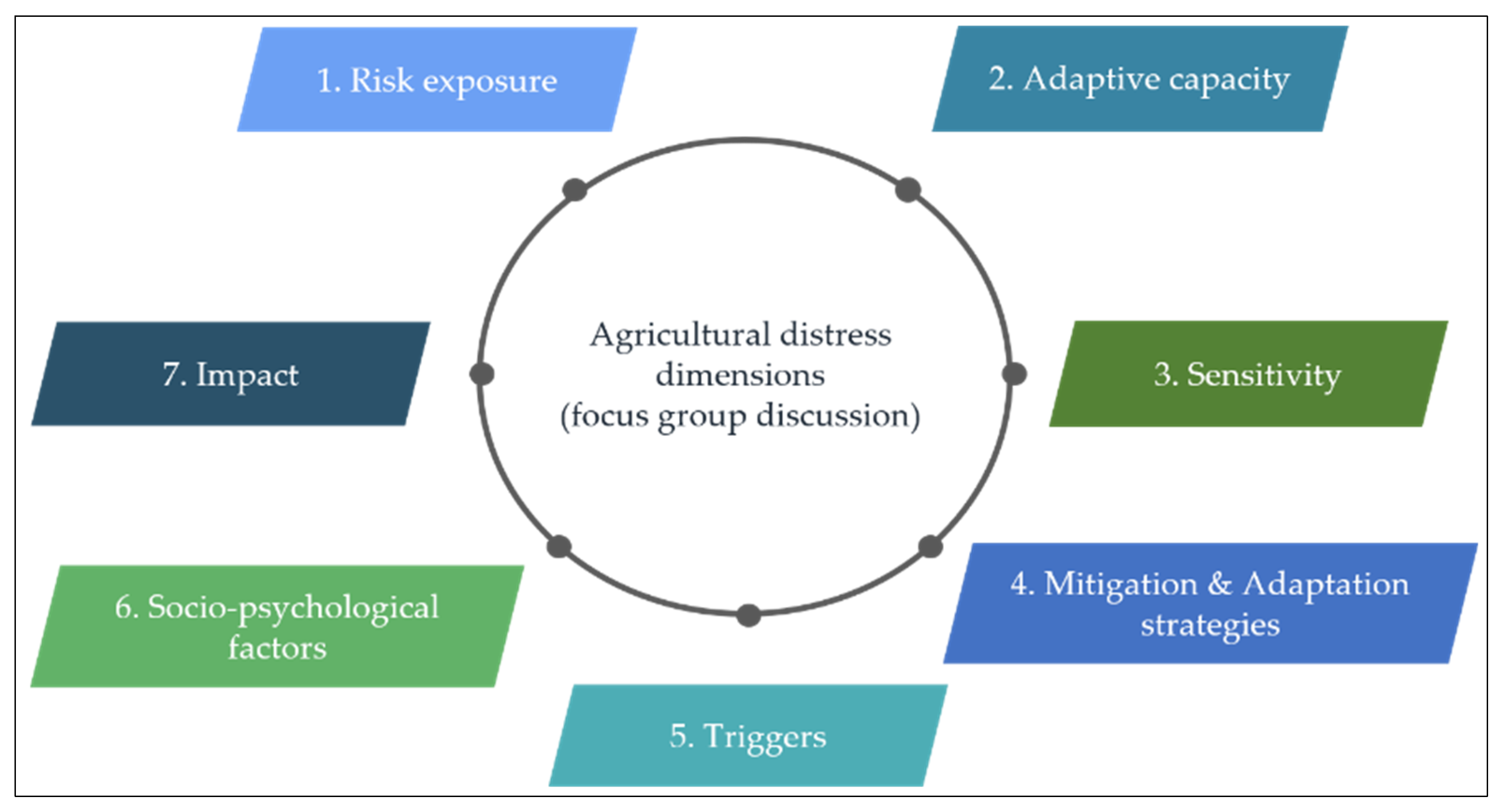
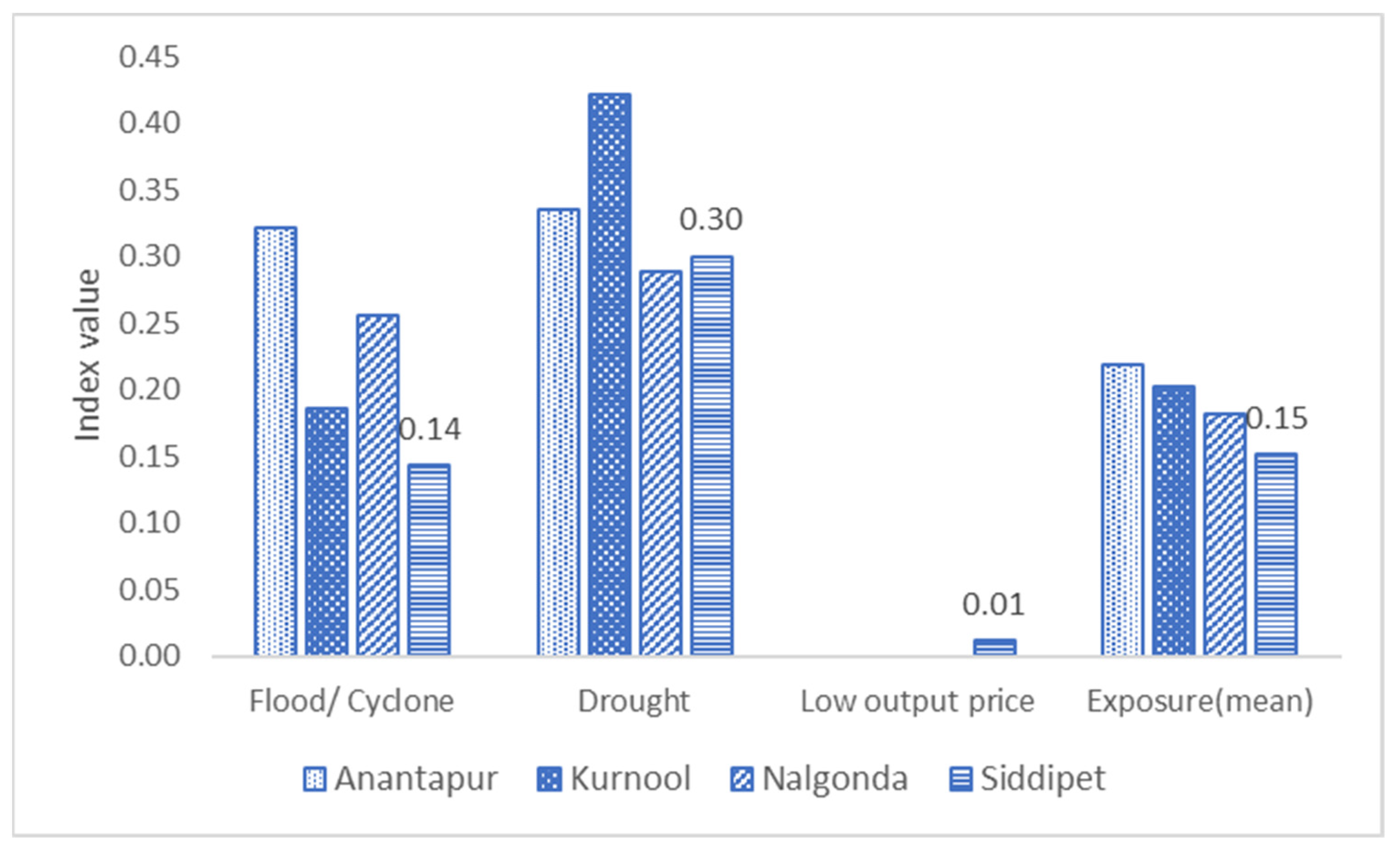
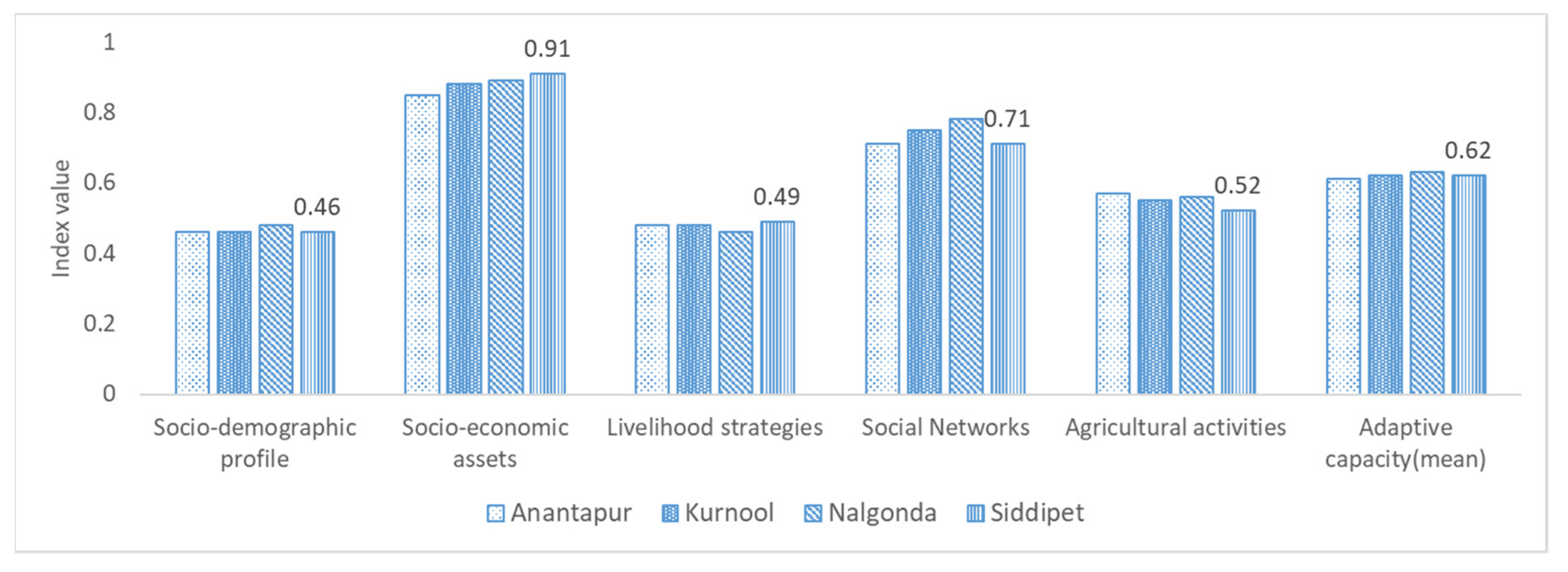
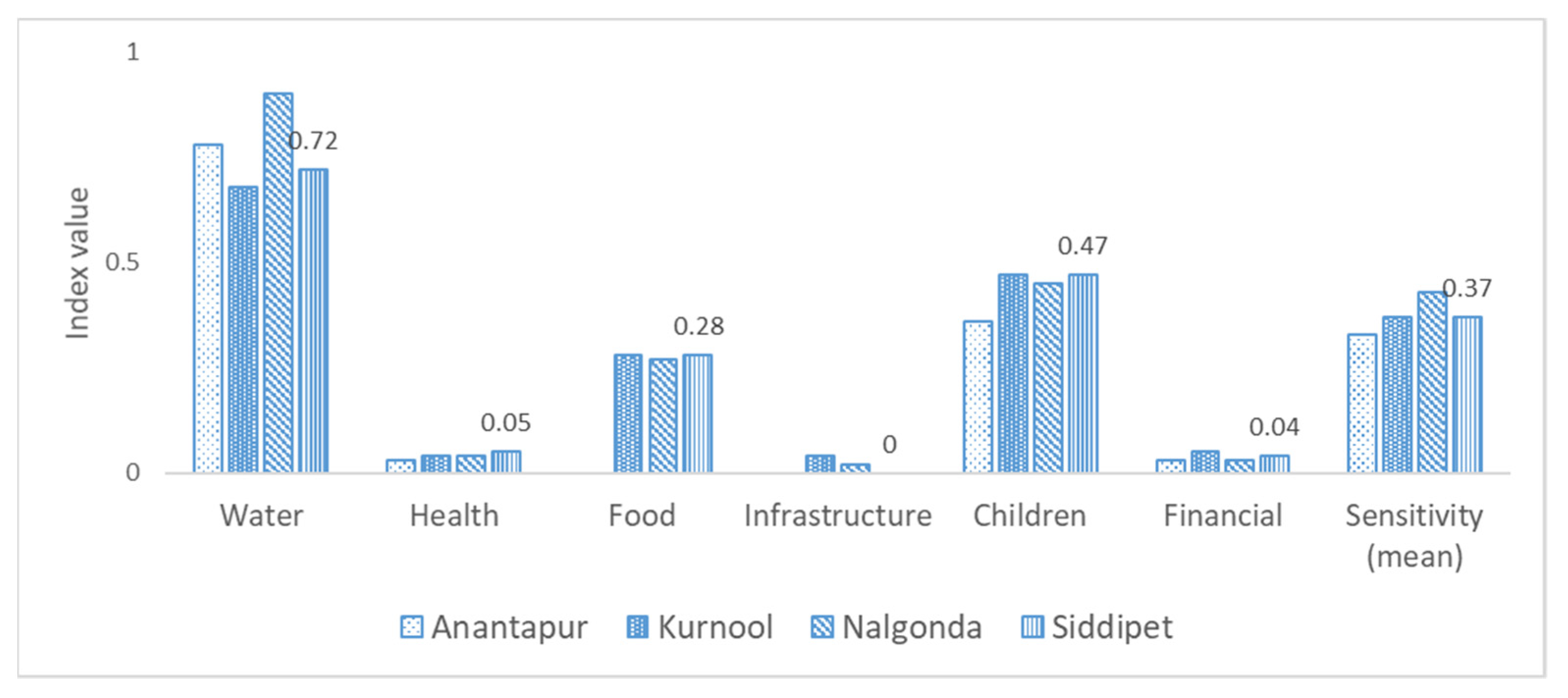

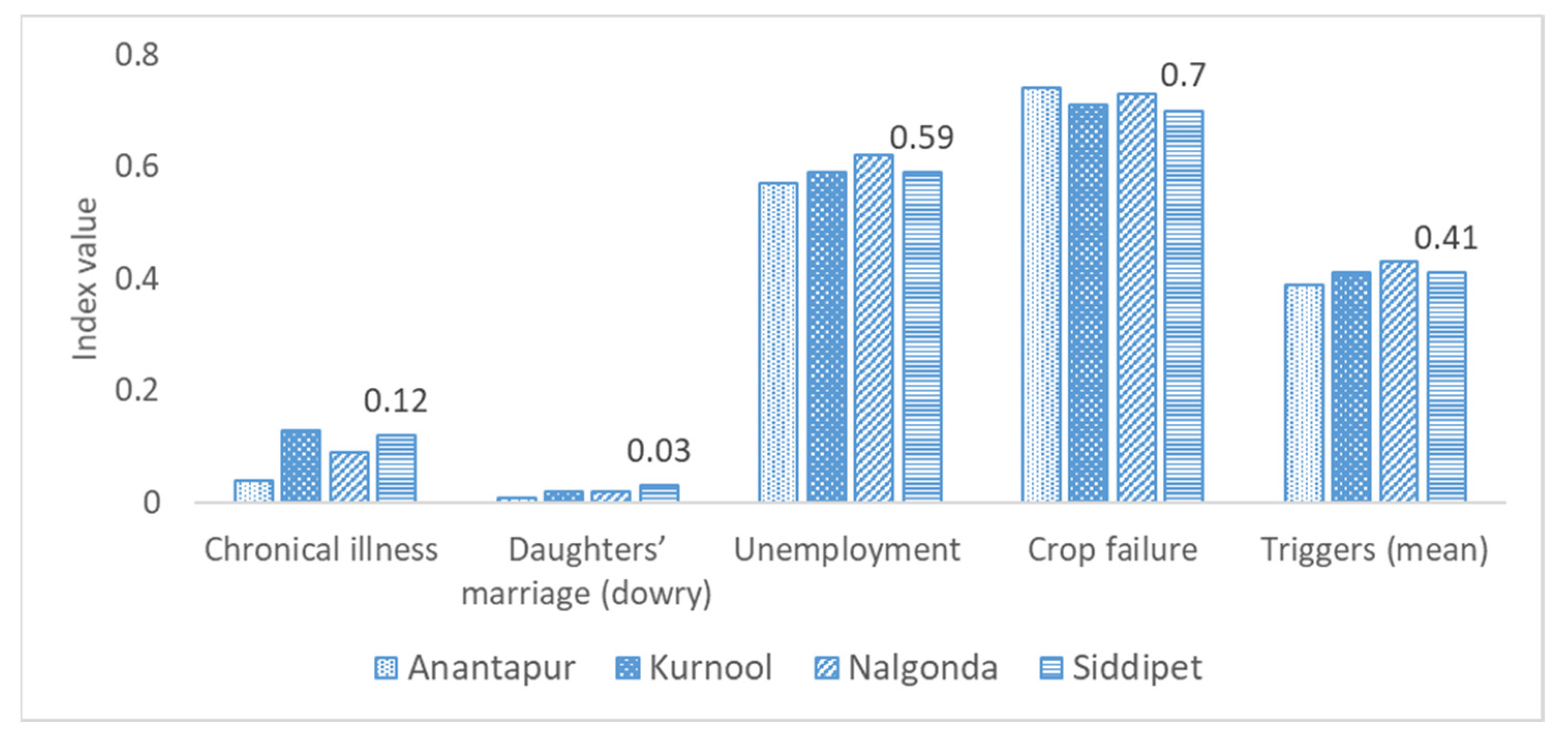

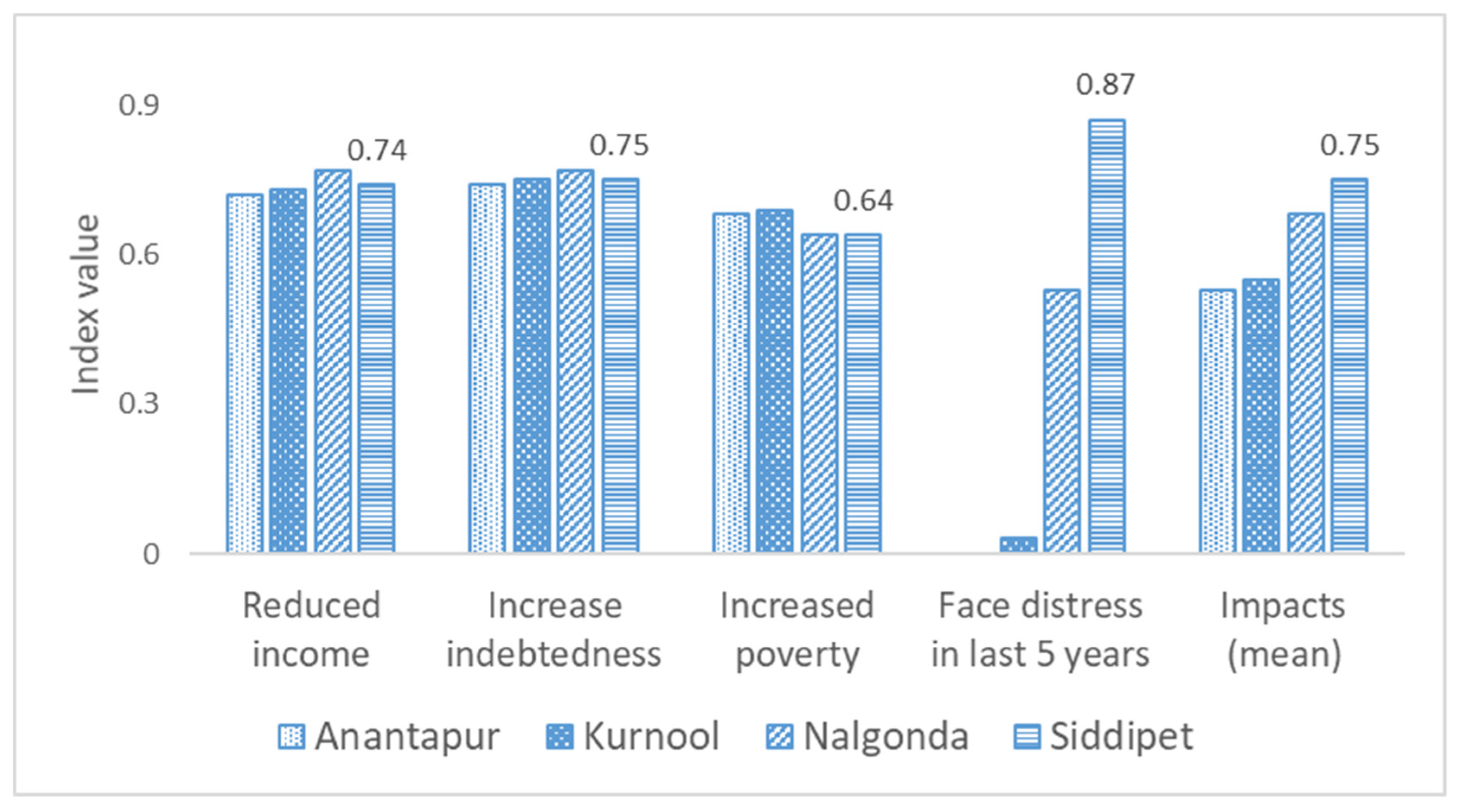
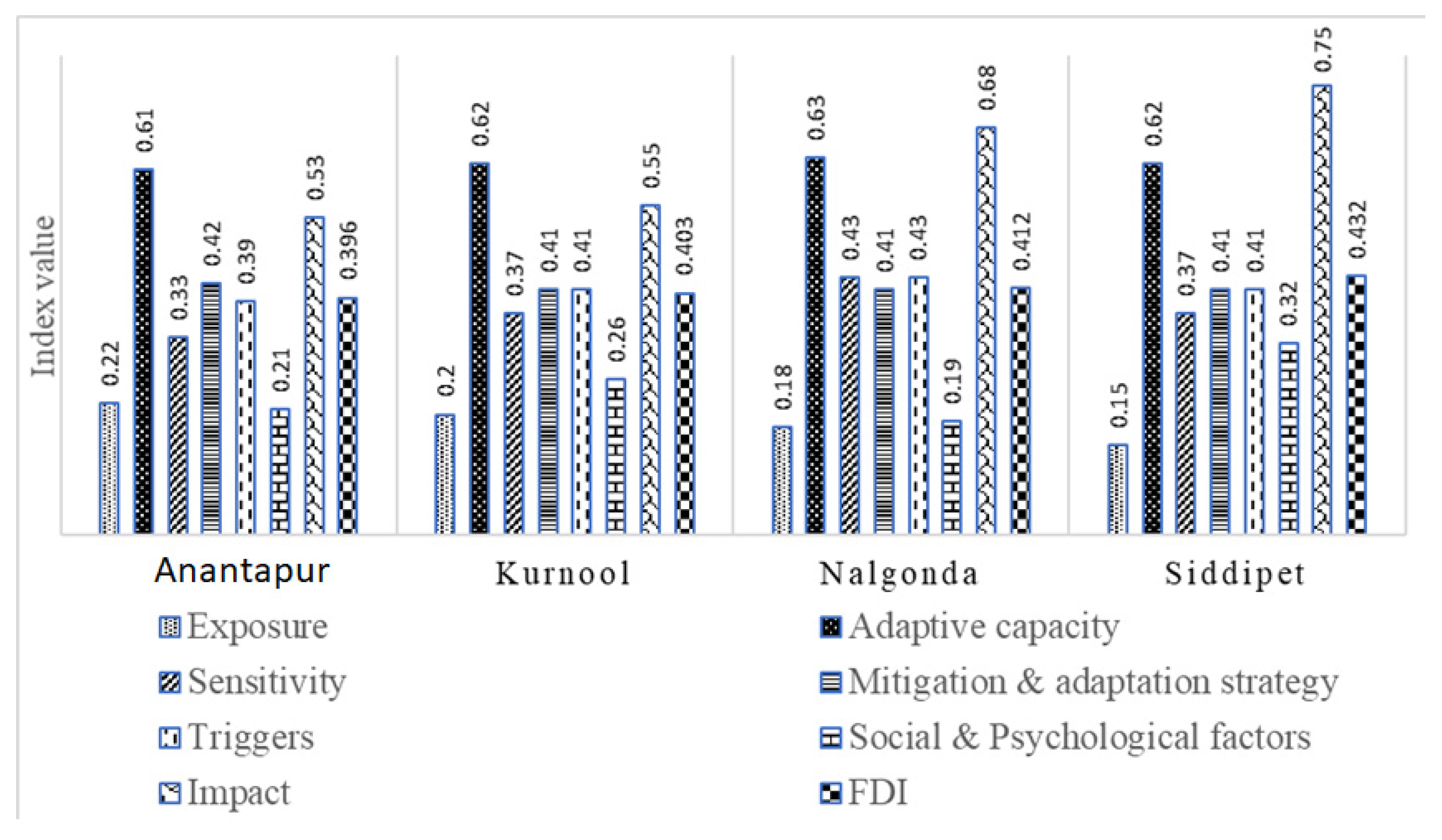
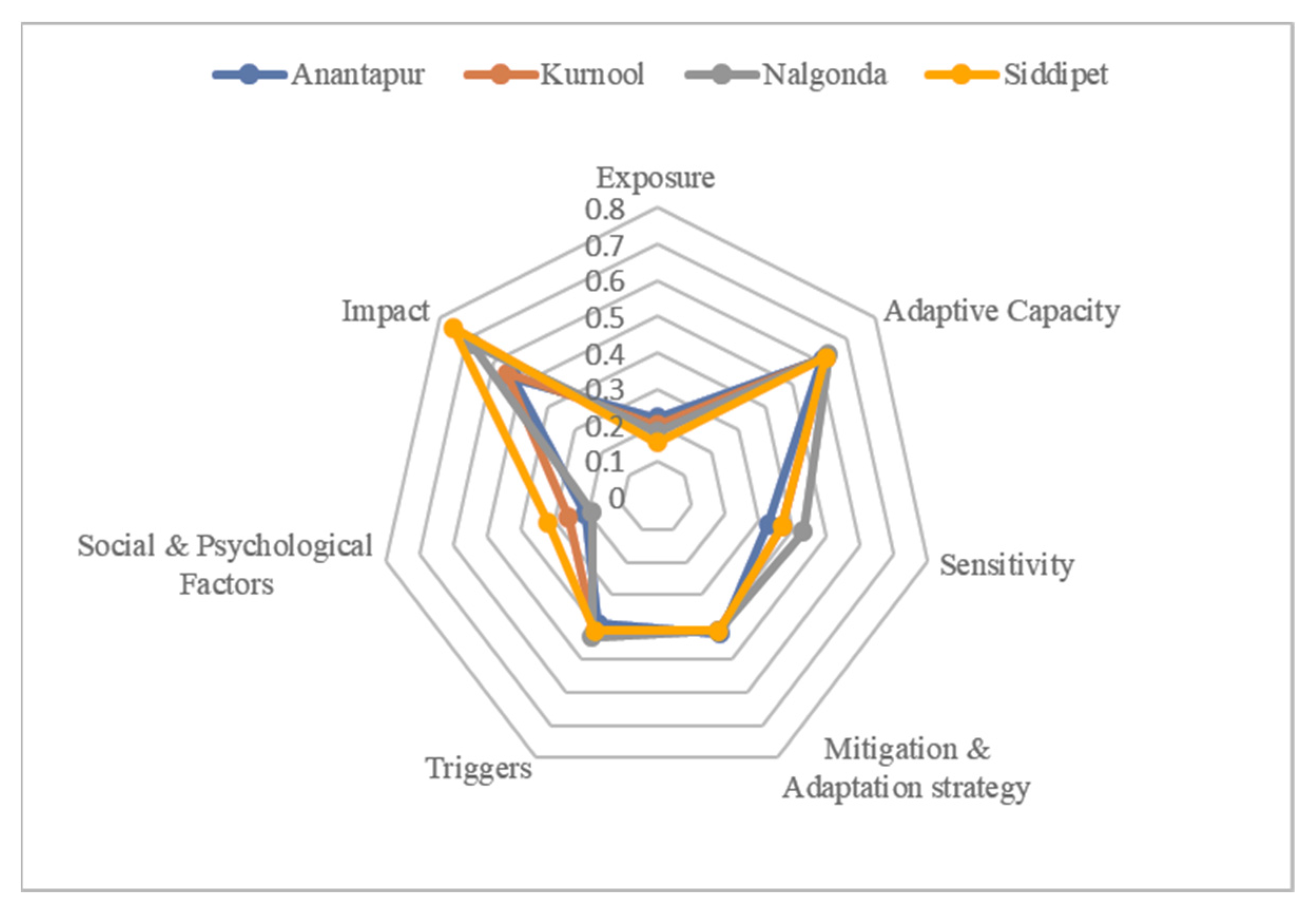
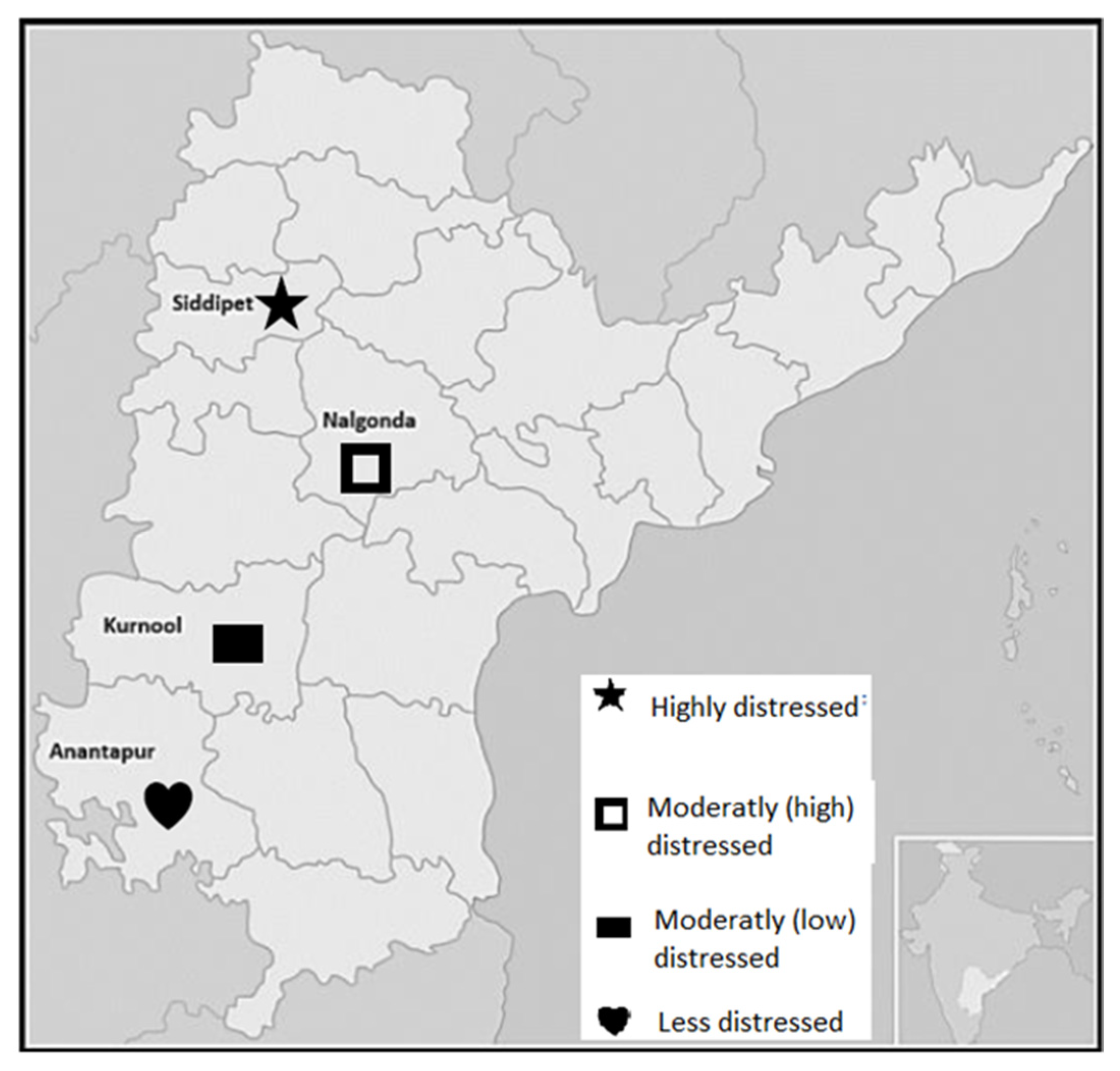


| Research Purposes | Analysis Tools | Data | Results |
|---|---|---|---|
| Identification of major indicators of farmers distress | Descriptive statistics using CREAM criteria [64] | Primary data | FDI |
| Identification of geographies (sub-district level) with severe farmers’ distress | FDI scaling | Farmers’ vulnerability mapping |
| Variables | Scores | Total Score | Selected Variables of Each Indicator with the Highest Score | |||||
|---|---|---|---|---|---|---|---|---|
| A | B | C | D | E | F | |||
| Indicator | ||||||||
| Standardization of indicator formula | Indexsw = (Sw − Smin)/(Smax − Smin) | Index Scale 0 = least vulnerable to 1 = most vulnerable |
| Major dimensions formula (7 dimensions) | Mw = (∑ni=1 Indexswi)/n | |
| Overall index formula (comprising 50 variables) | FDI = (∑7i=1 WmiMwi)/(∑7i=1 Wmi) |
| Dimension | Components | Variables |
|---|---|---|
| Exposure | Flood/cyclone, drought, low output price | |
| Adaptive capacity | Indices of socio-demographic profile | Sex, caste, religion, family size, elderly population, disability, sex ratio, educational status of the head, illiteracy, dependency ratio |
| Socioeconomic assets | House value, gold value, total land | |
| Livelihood strategies | Savings, income, Simpson Diversity Index (SDI), household expenditure | |
| Social networks | Membership in SHG, cooperative, agricultural cooperative, local cooperative | |
| Agricultural activities | Agricultural input, income from agriculture, profit, production cost, total owned land, total leased in the land, profit/acre, rainfed operational | |
| Sensitivity | Water | Provision of rainwater harvesting, failure of borewells |
| Health | Health expenditure, likely health expenses, chronic illness | |
| Food | Food expenses | |
| Infrastructure | Road | |
| Children | Children enrolled in private schools, likelihood of withdrawal of children from schools | |
| Finance | Indebtedness through informal source | |
| Mitigation and adaptation strategies | Farmer’s initiatives | Reduced cropped area, land kept fallow, low input use, reduced household expenses, borrowing from relatives and friends, borrowing from money lenders, migrated out as a casual laborer, participation in MNREGA, postponed health treatment, postponed marriages, sold livestock animals, engaged in animal husbandry, sending women for domestic work |
| Benefits from government schemes | From any formal institution, Rythu Bandhu, SHC, KCC, old-age pension, health scheme, child education, insurance scheme | |
| Adaptation strategies | Use own savings, migrate to other places, change cropping pattern, sale of assets, reduce expenditure on food, take children out from school, borrowing, depending more on non-farm employment, bonded labor, take support from local government | |
| Constraints in adaptation measures | Low education level, lack of access to information, inadequate capital, lack of extension services, land not suitable, lack of irrigation, non-availability of labor, lack of quality inputs | |
| Triggers | Health expenses, marital disputes, chronic illness, children’s marriage dowry, educational expense, other marriage expense, unemployment, lack of alternative income source, frequent pest and disease attack, outbreak of livestock disease, lower price of output, high farm expenses, crop failure, debt from informal sources | |
| Psychological factors | Social issues | Objection to the participation of women, catastrophe incidence in last five years, negative comment from society |
| Change in social position | Feeling isolated | |
| Mental harassment | Serious issue with society | |
| Family burden | Unable to fulfill familial responsibility, lack of moral support, major family issue | |
| Deterioration of economic status | Worried about financial distress, family issues regarding the deterioration in economic status | |
| Behavioral change | Addiction to smoking, alcohol, or drugs | |
| Loss of self-confidence | Chronic stress, loss of pleasure in economic activities, thought of ending life | |
| Impact | Reduced income, increased indebtedness, shortage in food consumption, purchased food from outside, increased poverty, deteriorating health, social stigma, sale of livestock/poultry, facing distress in last five years |
| Mandals (Sub-Districts) in Different Levels of FDI | |||
|---|---|---|---|
| District | Category A (High Distress) | Category B (Moderate Distress) | Category C (Low Distress) |
| Anantapur | Kanganapalli | Ramagiri | |
| Kurnool | Kudumuru | Pathikonda | |
| Nalgonda | Chandampet | Mariguda | Kattangur |
| Siddipet | Dubbaka, Markook | Mulugu | |
| Examples of Distress Indicators | Mandals (Sub-Districts) Need Major Intervention | Area of Intervention | Action Plan for Intervention | Responsible Bodies |
|---|---|---|---|---|
| Inadequate total household income/higher share of agricultural income/lack of non-farm employment | Markook | Strengthening and training of small enterprises | Encouragement of women/youth in engaging in cottage industry with farm waste materials | NGOs and skill development council |
| Reduced income and high indebtedness | Kudumuru, Mariguda, Dubbaka, Murugu | Credit support | Easy and smooth access of formal credit institution | Formal credit institutions (banks, cooperatives) |
| Low household assets value | Dubbaka, Markook, Murugu | Monitoring and proper delivery of various asset-generating schemes such as housing, vehicles, or agricultural implementations | Local-level government bodies (Panchayat) | |
| High farm expenses | Dubbaka, Mariguda | Cost-effective technology, subsidies, improving yields | Proactiveness of government with agricultural subsidy schemes to reach vulnerable farmers Farm mechanization Usage of renewable resources | State-level government body Research institutions, NGOs Dept. of agriculture |
| Income from agriculture | Pathikonda, Dubbaka, Kudumuru | Guaranteed support price, value addition | Effective implementation of minimum support price (MSP) Banks/insurance Small-scale processing plants | Local-level government bodies (Panchayat) Department of agriculture Income insurance |
| Low agricultural landholding | Kanganapalli, Pathikonda | Mapping of local resources and their management, development of land-lease markets | Adoption of integrated farming system, credit facilities to tenant farming | Local bodies Banks |
| Failure of borewell (lack of irrigation) | Chandampet, Kudumuru | Watershed development | Practice of water harvesting and conservation | Local bodies Community |
| Low educational status | Dubbaka | Capacity building | Provision of extension services and special training to farmers | Extension agencies Research institutions NGOs, SHG |
| Crop failure | Kanganapalli, Mariguda, Markook | Promotion of involvement in the mitigation program | Awareness of crop insurance schemes Identification of drought-prone areas Selection of proper crop varieties | Local-, state-, and national-level government bodies Insurance companies |
Publisher’s Note: MDPI stays neutral with regard to jurisdictional claims in published maps and institutional affiliations. |
© 2021 by the authors. Licensee MDPI, Basel, Switzerland. This article is an open access article distributed under the terms and conditions of the Creative Commons Attribution (CC BY) license (https://creativecommons.org/licenses/by/4.0/).
Share and Cite
Reddy, A.A.; Bhattacharya, A.; Reddy, S.V.; Ricart, S. Farmers’ Distress Index: An Approach for an Action Plan to Reduce Vulnerability in the Drylands of India. Land 2021, 10, 1236. https://doi.org/10.3390/land10111236
Reddy AA, Bhattacharya A, Reddy SV, Ricart S. Farmers’ Distress Index: An Approach for an Action Plan to Reduce Vulnerability in the Drylands of India. Land. 2021; 10(11):1236. https://doi.org/10.3390/land10111236
Chicago/Turabian StyleReddy, A. Amarender, Anindita Bhattacharya, S. Venku Reddy, and Sandra Ricart. 2021. "Farmers’ Distress Index: An Approach for an Action Plan to Reduce Vulnerability in the Drylands of India" Land 10, no. 11: 1236. https://doi.org/10.3390/land10111236
APA StyleReddy, A. A., Bhattacharya, A., Reddy, S. V., & Ricart, S. (2021). Farmers’ Distress Index: An Approach for an Action Plan to Reduce Vulnerability in the Drylands of India. Land, 10(11), 1236. https://doi.org/10.3390/land10111236












